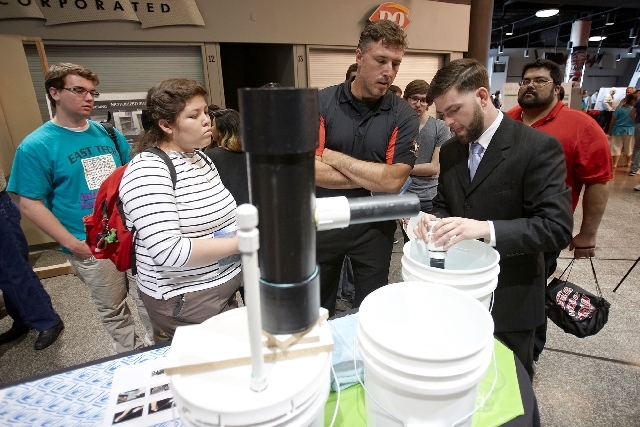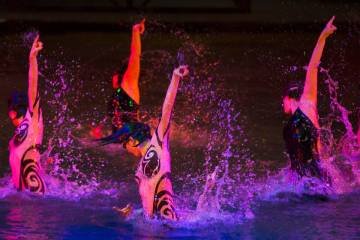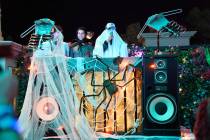UNLV students’ design project has practical use for villagers in Africa
Villagers in Moshi, Tanzania, may soon not need to make the three-mile round trip from their homes to a spring near the base of Mount Kilimanjaro to get clean water.
Civil engineering students at the University of Nevada, Las Vegas designed a system to transport water from the spring to an orphanage in the village. And at least one team member, Annie Bouck, plans to travel there this summer to help install it.
Bouck’s team, called Maji to Tuleeni, also includes students Eric Murphy, Brian Vincent and Christian Datuin. They won the grand prize at the UNLV Senior Design Competition May 9 at the Cox Pavilion. The competition is the culminating project for students in the Howard R. Hughes College of Engineering. More than 30 teams displayed their projects.
It is a 614-foot change in elevation from the village to the mountain spring, Murphy said. The water system project’s four components are an intake structure, a pipeline, trenching and a purification system. The system would end at an orphanage with taps for villagers to use. The team also designed a rain-harvesting tank for the roof.
“It’s definitely an awesome experience and taught us a lot,” said Murphy, who credits the group’s academic adviser, Jacimaria R. Batista.
“Dr. Batista really pushed us,” she said. “It’s a big reason the project was as good as it was.”
The team won the $4,000 grand prize and an additional $1,000 for the category of sustainability. It worked with the Virtua Foundation, a Christian nonprofit organization, to develop the idea. Murphy said the system would cost $50,000 or less, with about $40,000 being for the pipeline. Murphy said an engineering firm is also working on a similar system, and his team may work with that firm to install it.
The first-place team in the category of civil and environmental engineering was ZNE Portable Modular Building, which created an energy-efficient and self-sustaining portable building. These portable buildings could replace the older portables used by overcrowded schools. Team members are Paul McLandrich, Jared Noa, Ryan Goerl and Nick Natale.
“Really what inspired us to come up with that is the portable buildings we see at (schools) and how run down they are,” Noa said. “They’ve outlived their life span. We wanted to create an upscale portable building that doesn’t require any energy tapping into the grid –– no electrical or (heating, ventilation and air conditioning). We wanted to be sustainable and economical and at the same time have a nice look to it.”
The building would be 24 feet by 36 feet and have 20 solar panels on its roof with a 50-year life span. Tubes filled with water would run through the floor and ceiling and be heated or cooled to control the temperature inside.
The 2-inch metal panels in the walls would be lined with recycled denim jeans “to help with the heating and sound,” Noa said.
“The insulation is really important to this,” Noa said. “We’re trying to keep it as acoustically sound as possible.”
Noa said the group estimated that a portable would cost about $50,000 but that it would pay for itself in 20 years with the savings in electricity, after which time energy sold back into the grid could make the portables profitable.
“Besides being completely net-zero energy, you could actually make money each month,” Noa said.
First-place projects in other categories were:
n Computer science — GiftButler, an iOS app that provides gift recommendations for holidays, birthdays and other events. The app was developed by John Bertini.
n Electrical and computer engineering — Ghost Hand Keyboard, a device worn on the wrist, which creates a virtual keyboard that can be seen by a user wearing special glasses. The user can pantomime keystrokes over the invisible keyboard to type. Team members are Marc Gurney and Mike Misch.
n Entertainment engineering and design — Music Page Assistant, a device controlled by a foot switch that transfers sheet music to reveal the next page. It was developed by Timothy Lee.
n Mechanical engineering — Stirling Air Conditioner, a new air-conditioning system that uses the Stirling cycle, reducing energy consumption by about 10 percent. Team members are Jena Junsay, Keaton Frerker and Kaipo Kekaula.
n Interdisciplinary and commercial potential — The Reactor, a self-folding infant stroller with auto-locking brakes, LED lights and the ability to attach to car seats. Team members are Khoa Vo, Niloufar Afnani, Brian Corpuz and Ron Bohne.
For more information, visit engineering.unlv.edu.
Contact View education reporter Jeff Mosier at jmosier@viewnews.com or 702-224-5524.




























